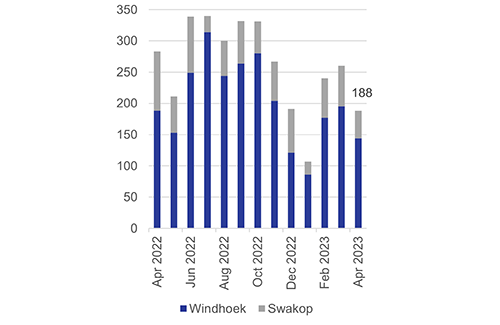Based on the current repo rate of 7.25% and prime lending rate of 11%, it is expected that elevated living costs will weigh heavily on consumer demand. This, in turn, is expected to impact the affordability of loans for new buildings, which is anticipated to further deteriorate and contract the already suffering domestic construction industry.
This precarious state of affairs has been brought to the fore by local stock brokerage Simonis Storm (SS) in its Building Statistics report for April 2023. In the report, SS noted the Bank of Namibia is scheduled to convene on 14 June 2023 – and as such, a 25bps rate hike is anticipated.
This would increase the repo rate to 7.50% and the prime rate to 11.25% – and as a result, the average home loan interest rate will increase to about 12.25% (prime plus one). Post Covid-19, corporate mortgage loan growth trended down, while household mortgage loan growth recovered steadily.
Meanwhile, the SS report also indicated that construction in Windhoek and Swakopmund experienced an approval contraction of 33.6% year-on-year (y/y) in April 2023. Meanwhile, for the year-to-date (YTD) from January to April 2023, an average of 151 plans were approved per month, whereas for the same period last year, 214 plans were approved per month.
According to SS, the decrease in building plan approvals is partly explained by the City of Windhoek receiving fewer plans.
“Indeed, YTD City of Windhoek received 191 plans on average per month, compared to 222 plans received on average per month for the same period last year,” the SS report stated.
Moreover, building plan approvals have decreased by 33.6% y/y, from 283 plans in April 2022 to 188 plans in April 2023 for Windhoek and Swakopmund combined. SS pointed out that the driver of this decrease is Swakopmund, decreasing by 53.7% y/y.
Meanwhile, Windhoek experienced 23.4% fewer approvals in April 2023, compared to April 2022, with approvals decreasing from 188 to 144. However, on a monthly basis, Windhoek and Swakopmund’s approvals in building plans experienced a decline of 26.2% month-on-month (m/m) and 32% m/m respectively, resulting in an overall decrease of 27.7% m/m.
“Similarly, building completions also remain on a downward trend. Completions decreased by 27.4% y/y in April 2023, compared to April 2022. Only 90 projects were completed, which is the lowest since July 2021 when only 43 buildings were completed across Swakopmund and Windhoek. These completions were concentrated in the residential segment of the market,” the SS report reads.
In addition, the majority of building plan approvals in both Windhoek and Swakopmund were concentrated within the additions segment of the market. However, these comprised only 26% of the total value of plans approved.
SS emphasised that 10 commercial and 70 residential plans were approved, with the largest value of N$62 million and N$60 million, respectively. The approvals amongst these three categories account for 97% of the total value of plans approved.
Overall, for April 2023, there was a significant increase in the value of completed projects, compared to March 2023, with a 48% m/m increase, albeit with only 90 projects completed (in both Windhoek and Swakopmund combined).
“It is uncertain whether this increase was due to large or value-adding projects being completed, or if it was influenced by inflationary pressures. Of the N$94 million worth of completed projects in April 2023, N$75 million were residential, N$14 million were commercial, and N$5 million were additions.
Lastly, the value of projects completed in April 2023 decreased by 19% y/y,” SS reported.


